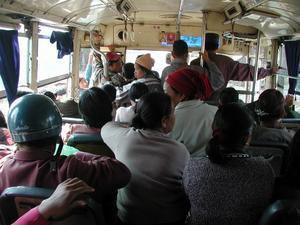Advertisement
Published: January 11th 2007

 2006-12-22 11-25-03
2006-12-22 11-25-03
The back half of the bus is loaded from floor to ceiling with goods. The front half of the bus is loaded with people, although not quite to the ceiling.On December 22, 2006, we took a morning bus from Hsipaw to Kyaukme.
Ann from Ireland joined us on this leg of our trip.
The bus was packed, with many big bags of rice/produce lined along the aisle.
Passengers just sat on top of the bags.
Kyaukme (pronounced Jau-my), is about a two hour ride south of Hsipaw.
It has a population of about 120,000, of which approximately 30,000 are of Chinese heritage.
We came to Kyaukme because the young Chinese Burmese invited us, while we were on the train the Hsipaw a few days ago.
We looked for the young Chinese-Burmese but unable to locate him. We left word at our guesthouse to have someone look for him.
We walked to the bus station to check out the bus back to Mandalay. It seemed like there are only a few seats left on the bus for the day we wish to leave, so we bought our bus tickets. After we purchased our tickets, a man approached us and ask where we came from. We told him we are from Hong Kong, and he immediately conversed with us in Cantonese. When we learned that his hometown

 2006-12-22 15-20-34
2006-12-22 15-20-34
Private tour by Mr Cho.is from Taihan (or Toishan), Gary spoke with him in the Toishan dialect.
This man, whom we later learned is called Mr. Cho, offered to show us around town. He brought his car around and took us to several temples. Not many Burmese can afford a car, and so we figure this man is pretty well off. He showed us the town area and point to a cinema, a tea house, a bar, a restaurant and told us they are all his. He also owned the bus line for the Mandalay-Kyaukme bus.
We guess we have just met the richest man in Kyaukme.
Mr. Cho also took us to a Chinese school. The Chinese community here in Kyaukme has kept the heritage. They put money together to build a Chinese school, which houses 600 students. The students come for 2 hours (6 am to 8 am) and 2 hours in the after (4 pm to 6 pm), in addition to their regular Burmese school. Mr. Cho was one of the founders of the school.
We are very impressed with the Chinese community here.
We thank Mr. Cho and went back to our guesthouse.
The

 2006-12-22 15-27-07
2006-12-22 15-27-07
Here is an imitation of the Golden Rock of Bagoyoung Chinese-Burmese man found us. His name is "Joy" (pronounced as "Droid"). He is a apprentice trekking guide. Ann agreed to go with him on a 2 day trek the next day.
The next day, when we woke up, we found out Ann has decided to only go on a one-day trek, and we went along. Joy, along with his 16-year old friend, took us to visit the villages and the temples. At almost every home in every village, we were invited to tea. All the villagers are very warm and are happy to have visitors.
We learned a few words in Burmese and Shan, on how to say hello and thankyou.
We visited a Nepal family. They are a little smaller in stature and all look very young. We thought her 16 year old daughter is only 10 years old. We visited a monastery and the monks offered us tea.
We visited some families whom their children have hardly seen foreigners. So no putting out their hands to ask for money (unlike in some touristy places, children are used to asking for money).
Later, Joy took us to visit the Chinese school. Now, the

 2006-12-22 15-43-21
2006-12-22 15-43-21
East side of kyaukmechildren were all having classes. We learned many of the teachers are volunteers. The school used the chinese language curriculum of the Singapore schools. We looked at the work posted on the bulletin boards and were truly impressed by the quality and standard.
We enjoyed our visit in Kyaukme.
Advertisement
Tot: 0.231s; Tpl: 0.012s; cc: 12; qc: 70; dbt: 0.094s; 1; m:domysql w:travelblog (10.17.0.13); sld: 1;
; mem: 1.2mb

 2006-12-22 11-25-03
2006-12-22 11-25-03
 2006-12-22 15-20-34
2006-12-22 15-20-34
 2006-12-22 15-27-07
2006-12-22 15-27-07
 2006-12-22 15-43-21
2006-12-22 15-43-21






























